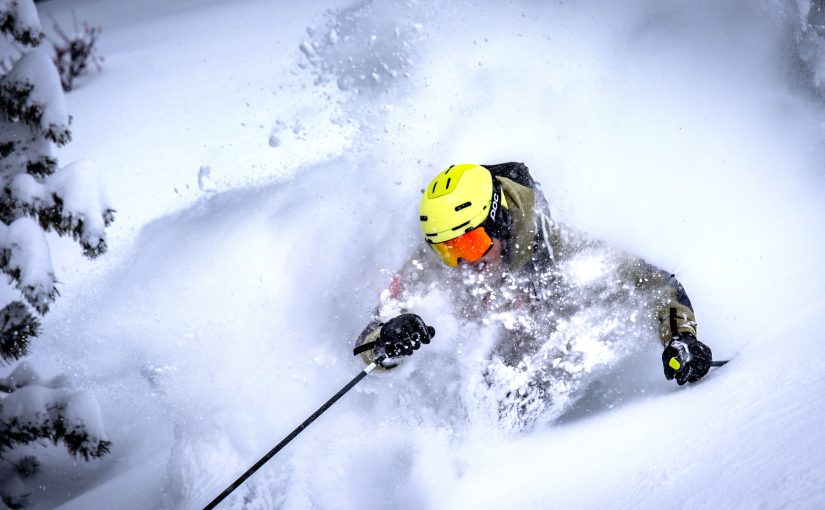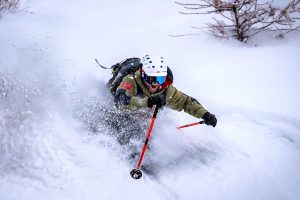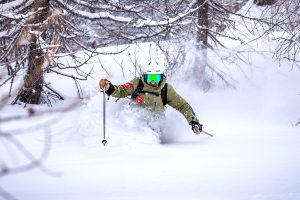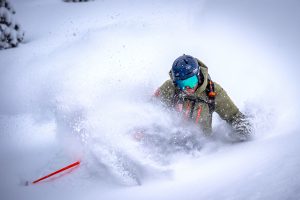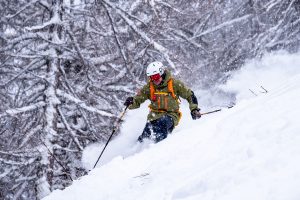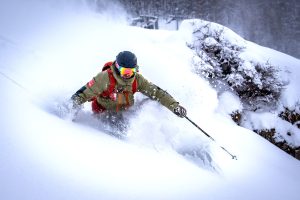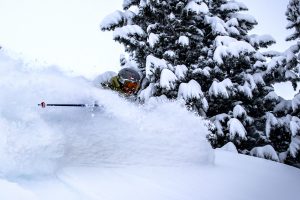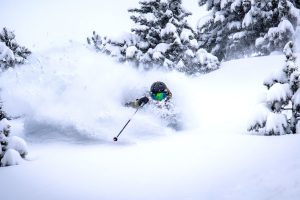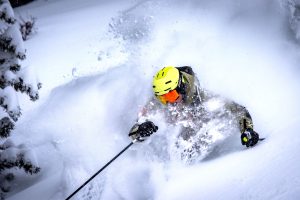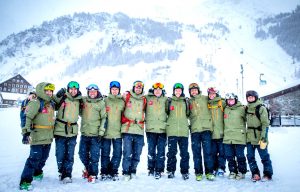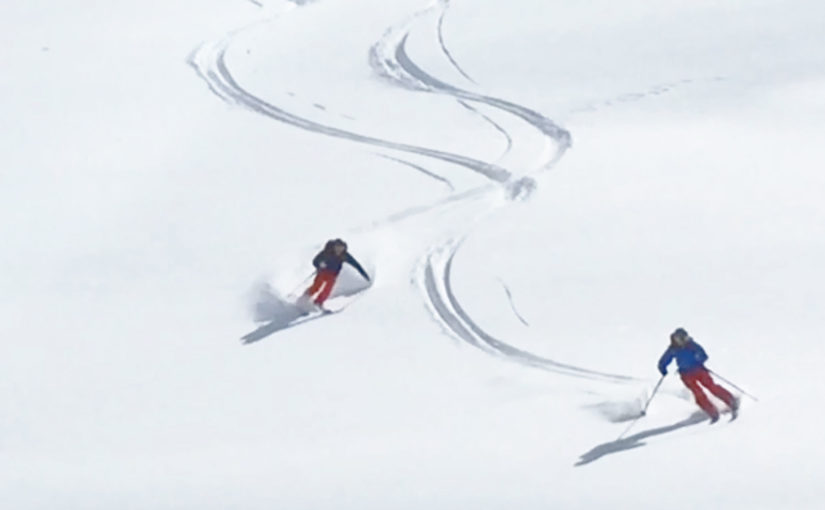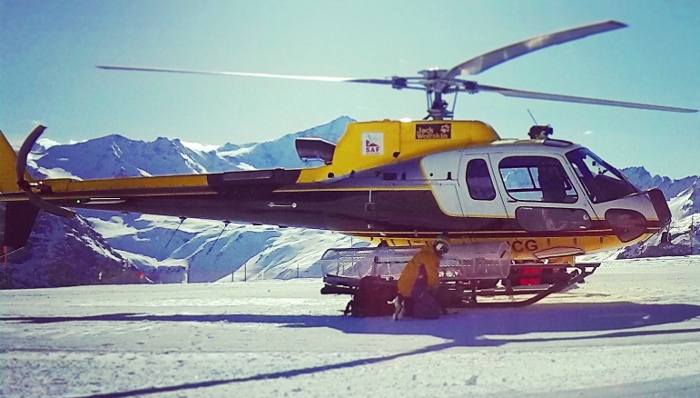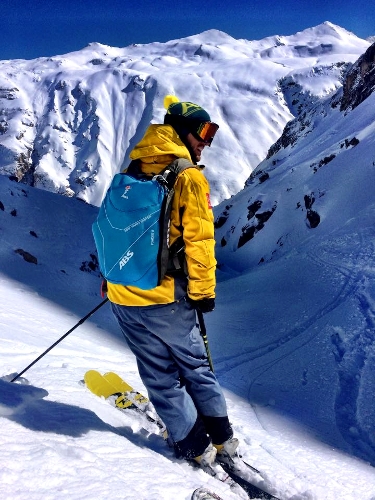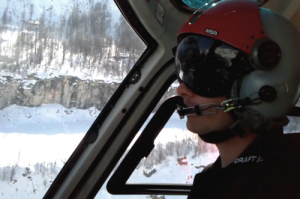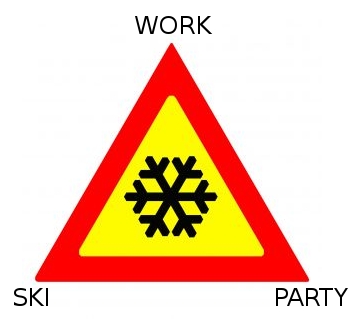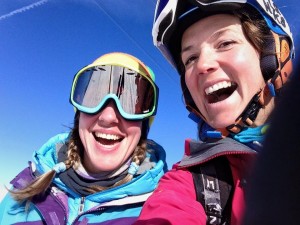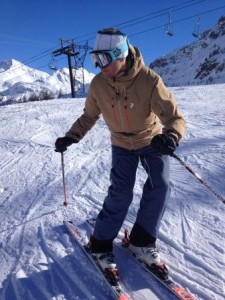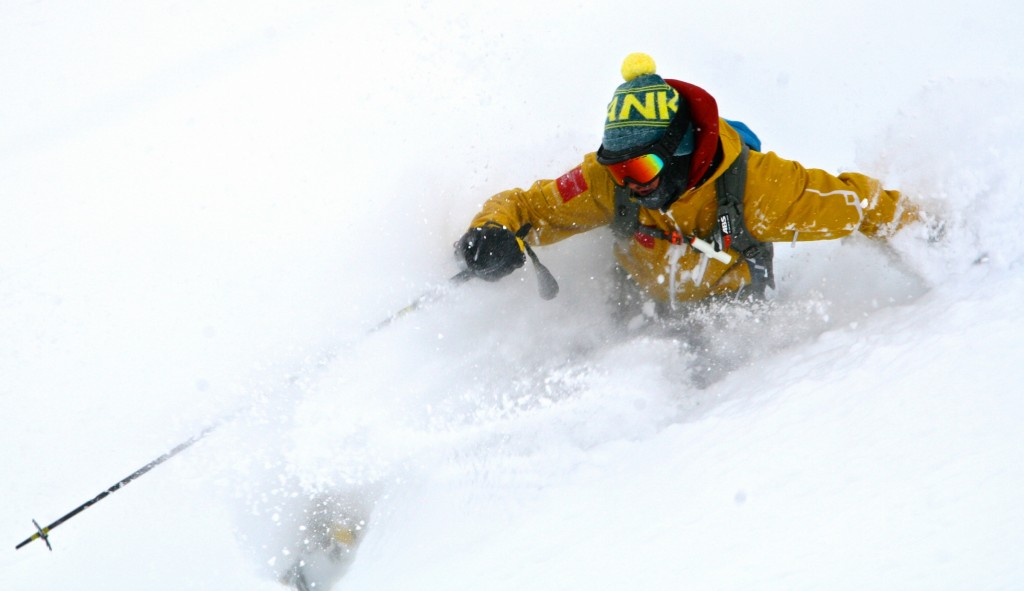Have a look at some of the great images we got on Val d’Isere opening day 2nd Dec 2023.
Photo Credits – Tony Wilkinson Photography
Tag: Skiing
Ski Touring – Kyrgyzstan
The TDC expeditions trip to eastern Kyrgyzstan this February was a fabulous success. The team flew from Heathrow/Gatwick/Geneva to Bishkek via Istanbul. Then transfered around the Issyk Kul lake, to within 100km of the border with China and Kazakhstan. The area is dominated by mesmerisingly white snowy hills/mountains visible into the extreme distance through broad valley clefts. The ski touring terrain here is dichotomously friendly and gradual whilst maintaining an aura of dramatic remoteness.
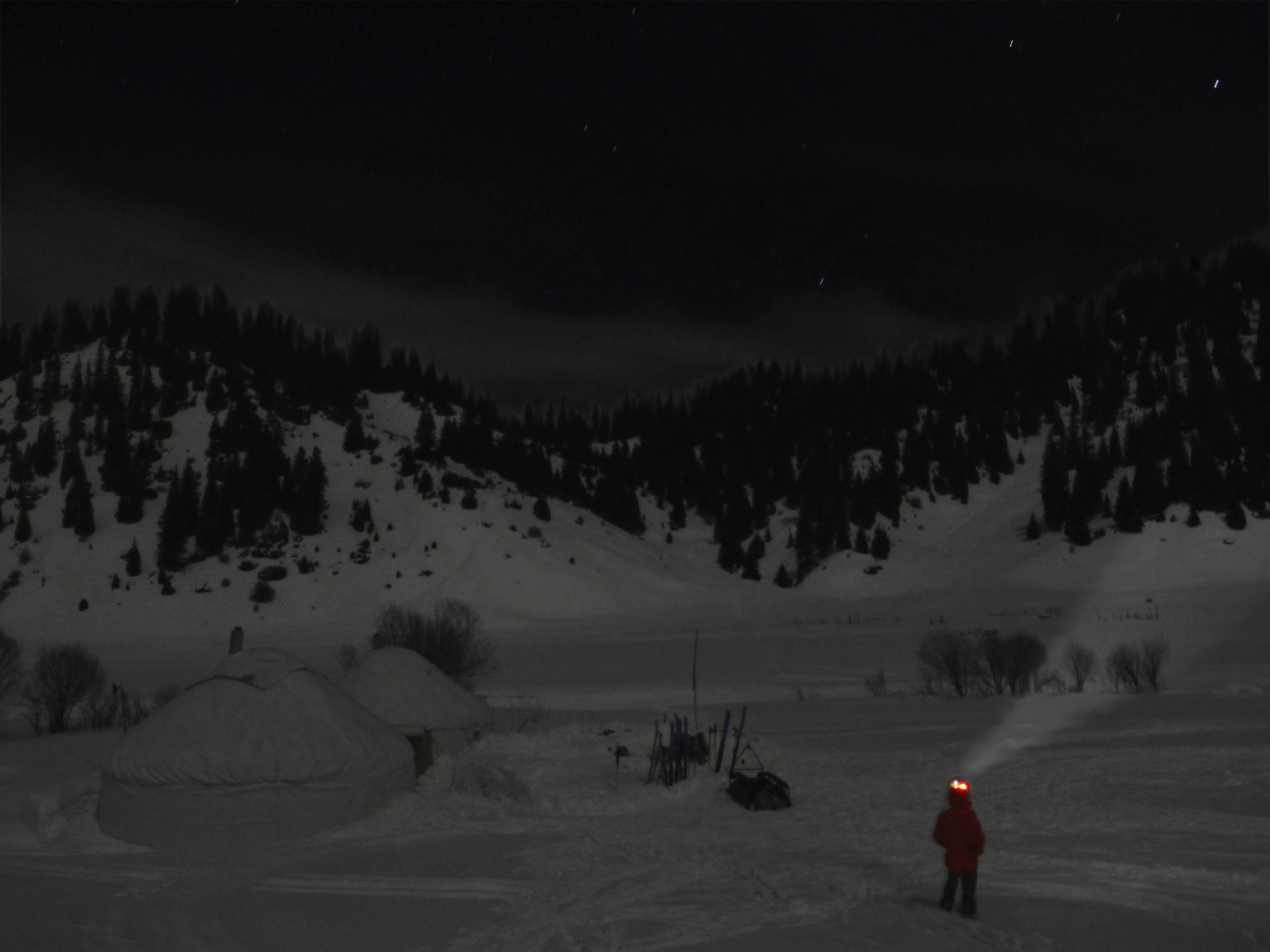
“I would unhesitatingly recommend it to anyone with a reasonable level of fitness and skiing ability who would like to experience something beyond the “everyday” off-piste / tour experience. It’s something I will always remember.”
– Mark, 2019
The trip is 10 days in total, with 1.5 days travel at either end. On arrival at the yurt camp, around noon, the designated Kyrgyz chef provides hot vegetable and meat (beef, lamb, chicken) stew for lunch. The food is extraordinary and cooked on a wood burner, camping gas stove, and portable oven, with dutiful competence by the chef. Breakfast involves milk porridge of ground either milllet/buckwheat/oats/wheat depending on the morning and availability. With eggs (4 for Ian), fresh bread and coffee/tea. Lunch was usually stew based, although occasionally the chef knocked-up some battered sausage hotdogs, or fresh apricot jam doughnuts!
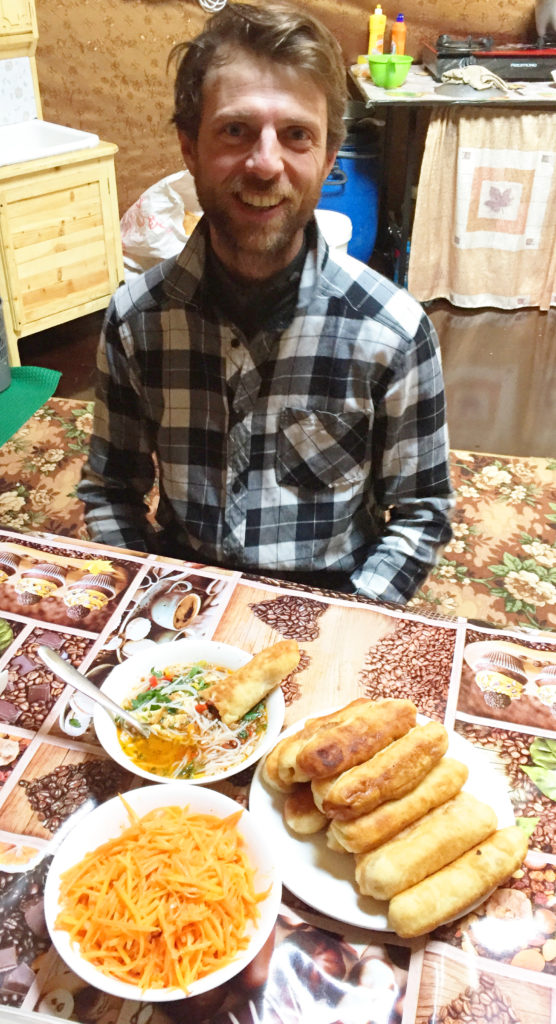
Dinner frequently involved more stew to start, followed with exeptional rice dishes somewhere between fried rice and biriyani. Then at other times involved almost British meat and vegetables, with delectably dressed salads.
The days in Kyrgyzstan revolved around the ski touring. Mornings can be bitterly cold, with the mercury plummetting to -25 at night. Therefore languid breakfasts, coffees and plans are maintained until around 9:30 AM, ensuring the suns rays and temperatures are sufficient. From the main ‘village’ camp, slopes are immediately accessible, touring from 1.5-3 hours to reach summits through ever-green spruce trees. The snowpack is unconsolidated in Winter and therefore requires gentle slopes (<25 degrees) for descents. This also maximises the number of powder turns to walking time ratio.
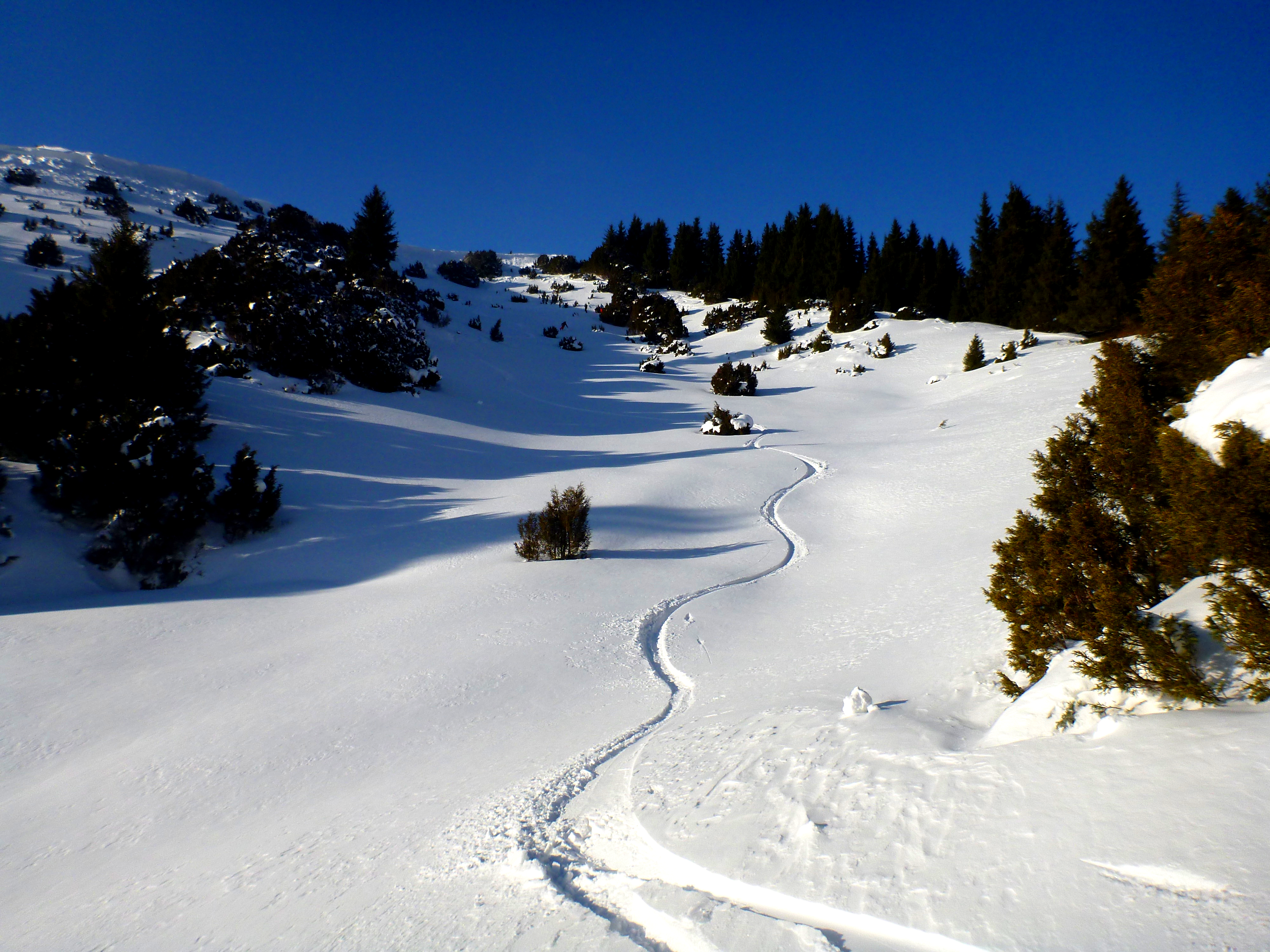
On return from the morning skin up and ski down. Hot lunch is prepared by the chef, and glycogen partially restored to any wanting muscles. After lunch is a chance for another daily exploratory, or known skin up one of the bountiful tributary valleys. It would be hard, and sometimes impossible not to get fresh tracks in this area. The snow is cold and unaffected by wind in the widely spaced forest areas, it therefore remains powder for effectively the whole Winter. This year we saw another team on a peak 2-3km away one morning, we felt gridlocked.
The advanced camp of 2 yurts (one cooking/dining and one sleeping), requires a 30min transfer via snowmobiles. This is exciting. One puts one’s ski pole through a loop in the rope tied to the rear of the skidoo, and hangs on. The journey percolates through some of the most dazzling alpine glades, cols, and plateaus imaginable. This year with a low orange sun, and long shadows creating a majestic light. This journey facilitates the use of the advanced camp.
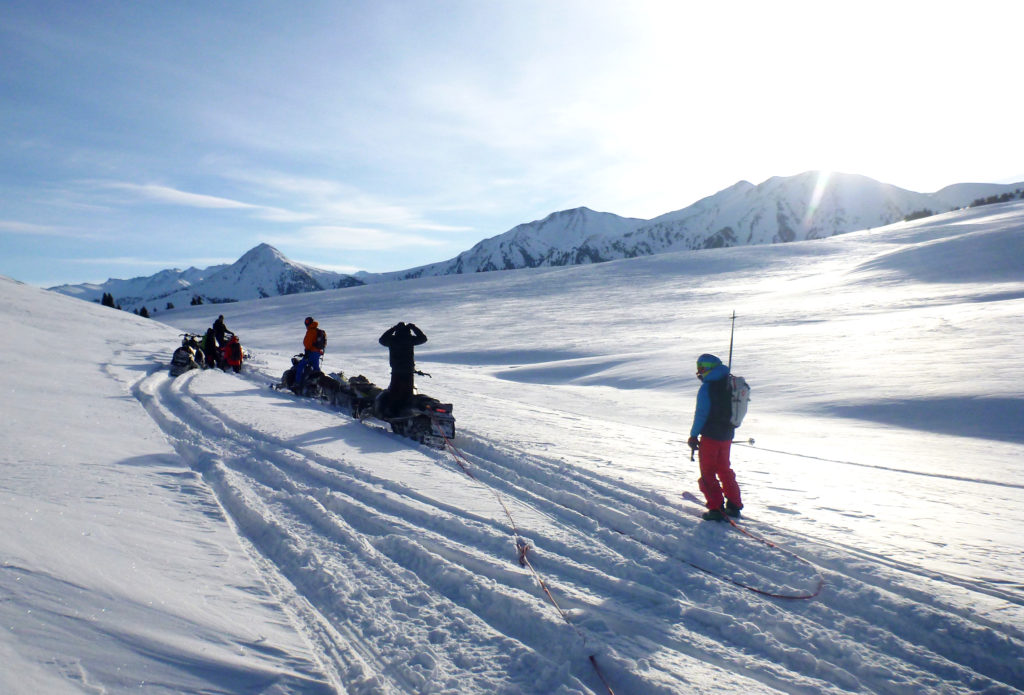
From the advanced camp, a non-intrepid sense of isolation prevails. Rich and Terry carry Sat-Phones and GPS locators for safety, receiving weather updates, and occasional updates from Penny, Rich’s daughter. But otherwise, this location is truely remote. The ski touring descents here are possible in a 360 degree vista. So that’s what we do. The same daily format ensues with a longer morning skin, and optional afternoon outings after lunch. One of the journeys on this years (2019) trip involved a 600m ascent through another stunning wide-spaced forest, and along a broad ‘knife-edged’ ridge to a shoulder of a mountain looking down our valley. From there a slightly steeper descent led the group 3 kms back to the yurts. That’s 3km of 20cm cold fresh powder on a smooth base.
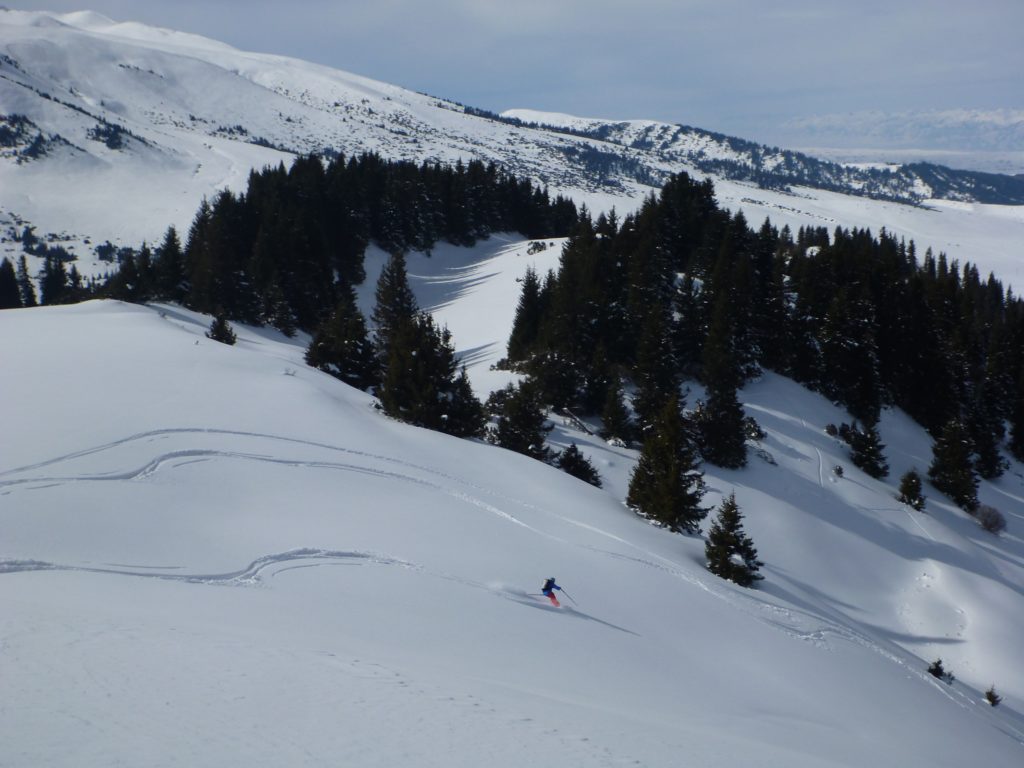
The trip involves ski coaching throughout. On day one we provide, transceiver training, skinning/touring techniques, and some navigation awareness. Throughout the trip there are 2 tdc coaches per group of 6 to assist with the skinning up, the transitions from touring to ski mode, and to provide technique and tactical instruction on the ski descents. The camp dog also followed us each day, providing joy for all as he bounded through powder on the descents.
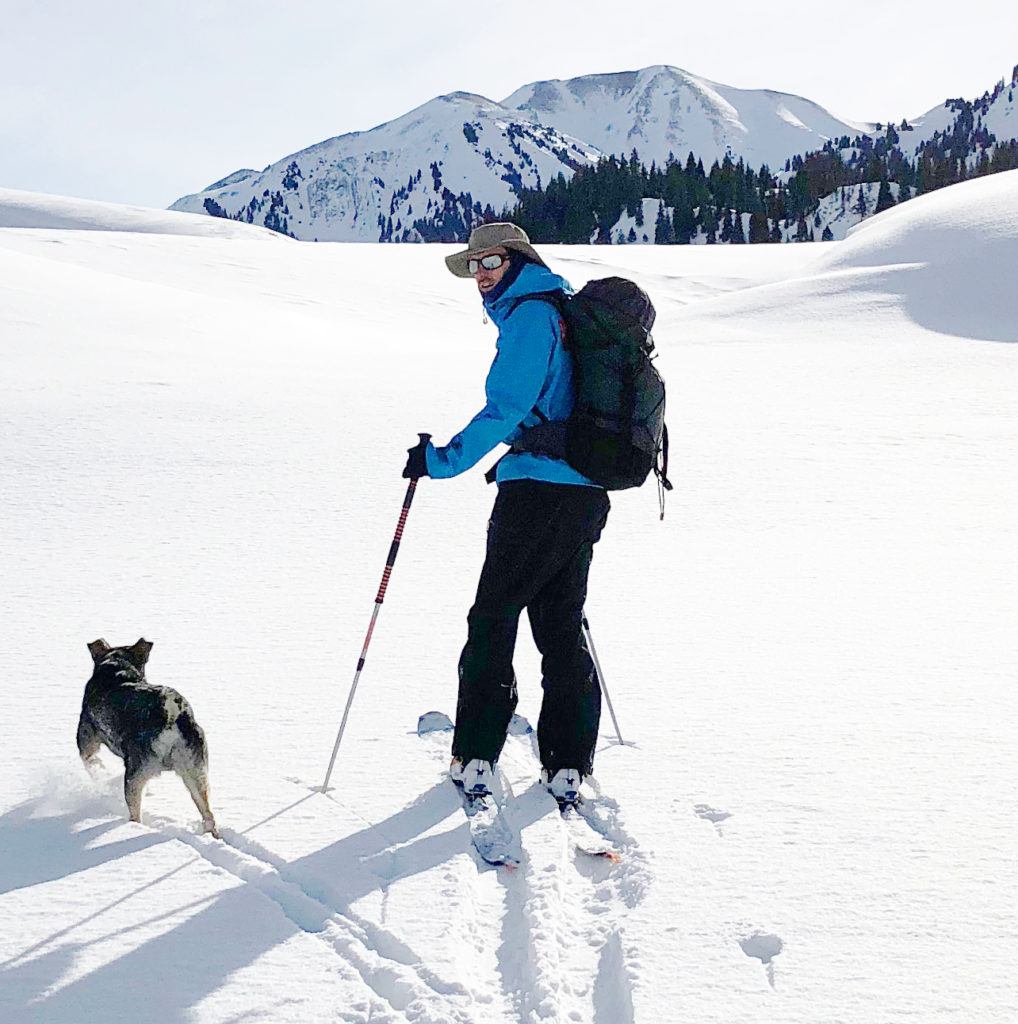
The trip will be running next February 2020, with limited space to keep the instructor to client ratio low. This helps ensure safety, speed across the terrain, enjoyment, and escalates learning curves.
To make contact about next year’s trip, please contact either [email protected] or [email protected] and for more info visit our tdc expeditions website (which is currently being updated – 7th march 2019).
tdc in Val d’Isere, Tignes and the 3 valleys are continually running ski touring and off piste skiing lessons and groups. Please visit the lessons section of our website for more information around those coaching sessions either in view of joining a future tdc-expedition, or simply to learn and enjoy a new genre of the skiing world.
HeliSki in Val d’Isere, France
In the Vanoise national park that incorporates Val d’Isere and Tignes, TDC coaches and clients ski to extremely cool and inaccessible places, then get a helicopter back out. Being dropped on top of a mountain is not permitted in France, but getting picked up in certain places at the bottom is fine.
Some of our coaches have had the requisite training and been signed-off allowing them to call in the helicopter and arrange the pick up. Amongst other things, this entails stacking skis, pacing out distances, and sticking your arms up in the air facing the correct way (over simplified).
Destinations that the development centre heliski guide / instruct to include:
Lac du Chevril – big dammed reservoir below Tignes, usually via an exhilarating route down.
Bonneval – over the back of the Pissillias Val d’Isere Glacier and down the other side.
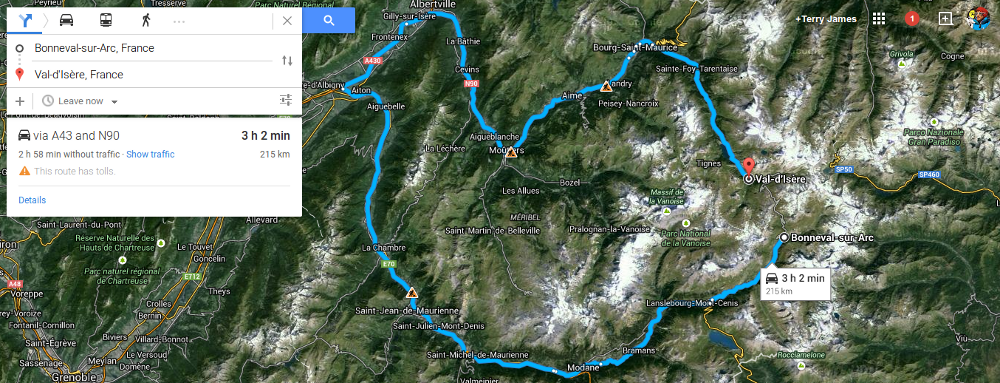
The heli pilot (undoubtedly the coolest looking guy I’ve ever met) can then drop back to the top of Solaise, bottom of La Daille, or in Val Claret to continue the off piste experience.
If any of this takes your fancy, then speak to our office [email protected] about arranging a half day trip (instructor and heli) from 340eu, or just bolt on a helicopter ride to your already arranged lesson, from 115eu
Bon Ski!
“Perfect day! Couloir & chopper action – tick! Thanks TDC” – Fliss
“Best day skiing of my life!” – Holly
Ski Resort Jobs – to becoming a Ski Instructor…
The TDC team have a great deal of experience in ski resort work from before they became qualified ski instructors. We gained valuable experience (and stories) along the way. Offices aren’t for everyone and the daily grind of academia can get you down too – so why not pack a bag and become an instructor? If you choose somewhere like Val d’Isere, then it’s likely you’ll be thinking about part-time or full-time work to fund the training and exams required to achieve the highest qualification in ski teaching.
Popular Option: Take part in a GAPski course for your Level 1 & 2, this will include: accommodation, food, courses, training, free skis and lots more!
Ski Bum with ample savings: you may wish to rent a lovely apartment and do the luxury ski bum thing, getting loads of skiing done, building your skills towards becoming an instructor and maybe taking on a level 3 or 4 course such as these.
Ski Bum with limited savings: you could still do the ski bum thing. But it could mean sharing a studio apartment with five (or more) people! Who generally won’t be keen on washing or cleaning. But you’ll probably be so busy skiing it won’t matter. It’s a great option saving money to put towards those instructor exams.
Ski Bum with extremely limited savings/debts: before talking about getting a job, there is one more option and this should be seen as a last chance saloon; sleep in your car for a season! [There will be a complete blog article on this next week]
Get a job: if funds are limited then there are a number of jobs in resort that will help keep a roof over your head and facilitate moving towards becoming an instructor. There will be three main aspects to your season: work, ski, & party. It will be tempting to try and do all three – though, will quickly become apparent that at least one of these has to give. Best not to let that be work! So really the choice is between skiing and playing.
Chalet work: this is a good choice if you want someone else to pay for your accommodation, lift pass, ski hire, food (& wine if you’re cunning)! The hours are perfect for maximising ski time – once you’ve struggled through the initial hectic weeks, you should be out by 10AM and shredding powder (or practising your snowplough). I worked for YSE and thoroughly enjoyed my time.
Ski rental shop: also a good option – all the better if you can work 30 hours over just the weekend! Get some sleep and you have 4 days off! You’ll work with all the gear, and hopefully end up having some idea. These hours also count towards those required for your BASI level 1/2 qualification. Snowberry is a good bet.
Ski school office: You’ll find out everything you need to know about the inner workings of a ski school. You’ll have access to free lessons and advice, be able to work out the ups and downs of life on the hill and learn first-hand about the trials and tribulations of the long winding road of instructor exams.
Stagiere / Trainee Instructor: It’s possible to work for a French ski school as a stagiere with a BASI Level 2 and test technique pass (slalom race). This is a great job and the ski school will usually offer plenty of support in finishing your diploma.
Other options: Bar work – if you can make sure you don’t party too hard after your shift you can still manage a good day on the hill. Waitressing work – ditto. Nannying – limited skiing, unless work is thin on the ground and then limited funds. Driving – you might find yourself working a lot when the lifts are open. Chalet maintenance – good choice, only if the chalet is falling down do you really need to curtail your ski day. Band/Solo musician in bars (tres cool).
Whatever you decide to do, whatever route you take, the key is to maximise ski and exam time – some jobs lend themselves to this more easily than others and some companies too. Do your homework about expectations so the job’s and yours meet somewhere in the middle. Working for TDCski, the development centre, we are all qualified to the highest level BASI 4 ISTD, with French equivalence. If you get the balance right – work enough to live, play a bit and ski ski ski… you could be teaching on the slopes in France too.
Coach Clare is currently teaching fulltime with tdc, after having a beautiful baby last April, managing the two is proving tiring, but probably nowhere near as tiring as her season as a chalet girl! [ed]
How to train your Monkey – Skiing Psychology
Have you ever heard a little monkey on your shoulder as you descend the pistes? It may have a very insistent way of commenting on anything you do, and will not hesitate to tell you how rubbish you just skied that run or how steep the next pitch looks…
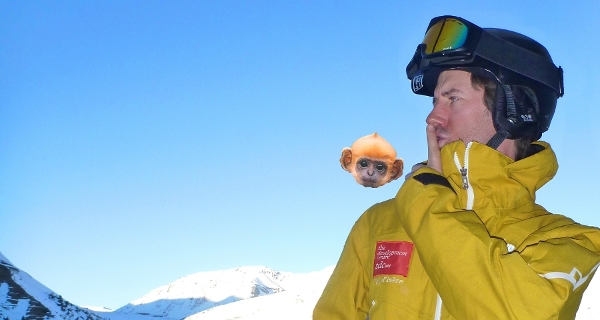
The monkey pretends to be doing you a favour as it reminds you of all your previous failures. It never supports you in what you are doing and it will insist on the fact that you will never achieve results. The monkey tends to speak in negative tones. It judges, worries, comments, compares and complains. The monkey is an outer image of how some of our minds work when they are left to their own device, untrained and untamed.
For various reasons some of us listen too much to our monkeys! We have become so used to the internal background commenting on our lives that we mostly forget that we do have a say in the matter. We could spiral downwards as this repetitive negative self talk influences our performance; learning could therefore easily becomes full of fears. In this instance, we are less likely to take risks, real or perceived. This has a potential to stop our growth and learning and can leave us feeling deflated.
When out coaching our clients, friends, (and even colleagues), we come across a fair few of these shoulder monkeys, and managing the louder ones is an essential part of what we do. We all have one and the moment we recognize our own monkey/negative self talk and learn to control it, our ability to learn improves rapidly and greatly. This psychological factor, is for some, a far more critical focus towards improving our skiing than any technical input.
But how do we manage the monkey and turn negative self talk into positive self talk? How do we train it?
To start with, you have to make a decision. You have to be willing to take the risk of stepping out of your comfort zone. Let go of the control. Be aware that doing this makes the monkey jump and scream on your shoulder! Take no notice of it! You want to do this because this is where we know we learn new skills. Learning starts where your comfort zone ends. You must accept the feeling of being vulnerable and uncomfortable.
Tell your monkey to stay calm and carry on. Be focussed on what you want, not the monkey.
For the TDC coaches, whatever your level, this is the very core of why we love our jobs so much! Helping people make that jump and realize that they still have two feet to stand on, is très rewarding. Monkey negotiation is amongst our favourite disciplines and a lot of our experience obviously comes from training and taming our own monkeys.
Listen to your thoughts….
Be witness to what your monkey is telling you. Just listen though, don’t evaluate or judge.
You will soon realise the separation between the voice of the monkey and you. This will give you the insight to change your self talk. Are you filled with self doubt? Do you tell yourself that you can’t do it? When your heart is racing, and you fail to commit, your monkey can beat you up for being ‘weak and useless’. You can even visualize yourself tumbling down the piste, and you haven’t even started! Is it the same old record playing over and over again?
Once you learn to witness your thoughts you can take charge of them, the monkey will lose its power. You will have started the process of taming and training your monkey.
Secondly….
If your monkey is being very loud and you can hear the negative self talk, think STOP! Visualize a big red/white stop sign. Give yourself a moment to clear your mind and replace the negative talk with positive self talk.
For example let your sentences start with I will… instead of I can’t… Tell yourself what you want to do. “I am learning to be a great skier”, “I will make 10 smooth relaxed rounded turns Now”. Mime a song and ski along to the rhythm. Really simple realistic positive affirmations like these can shut off the negative self talk. It does take practice and perseverance but over time control of self talk can become a very powerful tool in your tool box.
Override the negative self talk, and it will help you maintain control over personal feelings and behaviours, thus gaining confidence and improving learning.
Lastly….
Laugh at yourself… A lot! Have fun. You are allowed to be less than perfect. Take a leap of faith and you might fall but you might also succeed. If we hang out in our comfort zones, we mistakenly attach ourselves to the idea that the world is a predictable safe place. That is an illusion which can set us up for frustration and disappointment. Learning is change. Change implies that something is done differently, and it starts with our thoughts, with ourselves. With a choice.
So next time you go out in the mountains, have fun, take that monkey for a ski, find the edge of your comfort zone and then leave it (take care, and maybe listen a bit when jumping off cliffs though).
We would love to hear any stories about your monkey and how you may have trained it.
Coach Lena works to eradicate and make extinct shoulder monkeys, but it should be noted that she loves all furry animals and is very almost a vegetarian [ed].
Banishing some half-truths about ski technique
When learning anything, it’s good to keep things simple. But if we make things too simple, then we can be wrong as often as we are right. Here are a few commonly held views on ski technique which are too simple to be right all the time.
ALWAYS FACE YOUR SHOULDERS DOWN THE HILL
This can be pretty uncomfortable, but some people strive to do this all the time. I find facing the same way as my skis more comfortable, and therefore make it my default position.
When to do it (face shoulders down-hill):
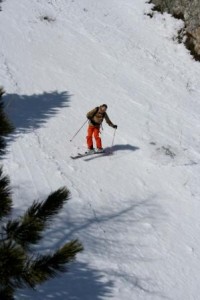
- To help initiate turns, especially on steep terrain, but it’s not necessary to hold the position
- When skiing linked short turns
- When skiing really tight and steep couloirs
- If skiing a straight/direct/inside line in the bumps
When you don’t need to:
- Most of the time…
GOING UP AND DOWN
When you would do it:
- On Piste: We all go up and down a little bit, it can help take us from one ski to another (see point 4 – ‘spreading the weight’), but critically, it facilitates lateral body movements inside the curve and across the skis. We don’t just do it for its own sake.
- Powder snow: It often looks like short turns in the powder snow involve more up and down, but this effect is really just the re-bound of the skis (pushing the attached skier upwards) as the skis work in and out of the lovely bouncy fresh pow!
BEND THE KNEES
Yes, we need to flex our knees in order to ski, and can’t ski well with stiff, locked legs.
How much to do it:
- A bit. We also need to bend at the ankle joint inside our boots and at the hip too – a bit.
- Remember that skiing is not a static sport, so static positions and prescribed shapes are not terribly useful except as a base position to move from.
When to do it more:
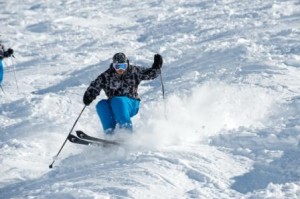
- When absorbing bumps
- When creating big angles – flex the inside leg whilst keeping the outside leg strong enough to resist the forces.
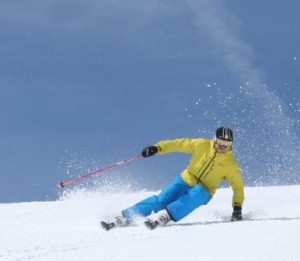
MODERN SKIS REQUIRE WEIGHT TO BE SPREAD OVER BOTH FEET
Well, no. For recreational skiers the outside ski is the one to put more weight on, especially at the end of the turn when it is the downhill ski. We do need to steer the inside ski, but don’t stand on it too much.
Any exceptions?
- When going straight
- Standing still on the flat.
- In soft snow, but only a bit. The outside ski is still dominant.
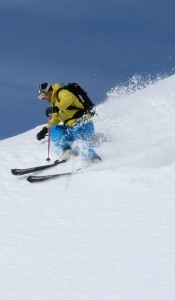
At the development centre, we share a coaching philosophy which tries not to set hard, fast and simple rules.
We work by linking any actions we make, to the results that we desire. This allows us to be adaptable and progressive. We do try to keep things simple, but not so simple that we are trapped by unhelpful and dogmatic “technique” for its own sake. In our coaching sessions; (as part of a group, or privately) we take beginners through to advanced skiers, both on or off piste, and justify our teachings with reason. We embrace some grey areas, and steer away from doctrine; that’s what makes being a ski instructor so interesting.
Remember though, technique is only part of it. We work hard with tactical and psychological subjects to improve overall skiing performance and enjoyment.
Coach Giles, is a ski teacher, a director of The Development Centre, and assessor of British ski instructors to the highest level. High amongst his most proud moments,is Fraser Hopewell passing his L4 technical exam [ed].
Photos by Ben Langridge : benlangridge.com
Henry Meredith Hardy: www.skiingsomewhere.com
You know you’re a Ski Instructor when…
- Your 1TB hardrive is full with box sets like Homeland, Dexter, Breaking Bad, etc.
- You have bunions and spurs at 22 yrs old.
- Xmas and Easter are the opposite of holidays.
- The number of clients you teach in a day, is the same as the number of times you answer questions about ‘what you do in the Summer’.
- Questions like “How many skis is too many?”, lose all meaning.
- You haven’t eaten a ‘super-food’ for over 4 months.
- You wonder if it’s possible to overdose or die of cheese.
- You can’t feel your fingers or toes for at least 2 months of the year.
- You’ve lost all faith in meteorological weather forecasting accuracy.
- Genepi actually tastes ok.
- Your Planks beanies, are as much of an everyday item as your pants.
- 10pm is a late night.
- All hip flexibility is long, long gone.
- Your thumb is deeply scarred from slipping off your file guide whilst sharpening edges.
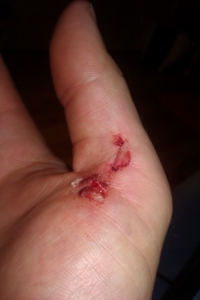
- Your edges are blunt because you serviced your skis too much whilst training for Eurotest and lost the love.
- When someone mentions ‘tip’ you don’t initially think of the end of your ski, or the bottom of your pole.
- A multi socket extender plug with adapter is the most useful thing in your life.
- A person pulling down the chairlift bar too fast, trapping your 6 yr olds leg, makes your consider waterboarding then murder.
- You feel no humiliation in shaving your legs/shins.
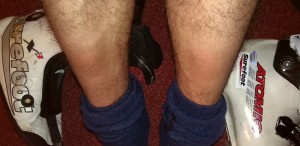
- You don’t want a goggle-tan like other seasonaires do.
- The living space of an organic free range chicken is greater than your 20sq/m flat, which you share with three people.
- You spent more time and money on your badge than your university degree.
- You would trade 15 slimline dishwashers for 1 washing machine.
- You realise ‘No friends on a powder day’ is not actually true. Who would dig you out, or help you search for a lost ski for an hour, or take epic photos?
Would you… risk learning?
What level of risk are you prepared to take when you’re skiing? Are you a risk averse, fair weather slider or driven by the adrenaline of skiing fast and steep? It takes all sorts and at TDC we ski with a huge range of performers and that is part of the attraction of this wonderful job. One of the great fascinations is observing, and sometimes influencing, how people approach learning and seeing how learning and risk interact. In order to learn one has to risk attempting something new. It may be a small step and a small risk but it needs to be there nevertheless. Without it the dreaded plateau beckons, and at worst – decline.
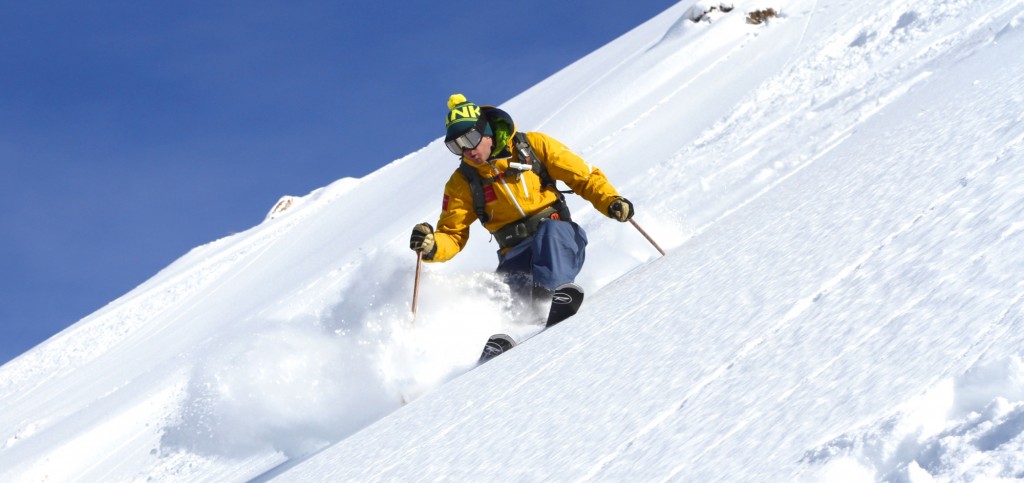
For some the very mention of risk is enough to set knees trembling yet most people want to get better at skiing. Fortunately it is not the level of actual risk but the level of perceived risk that is central to learning. For a nervous intermediate who feels frightened of pointing the ski downhill on a blue run, the perceived risk of doing so is potentially greater than that experienced by an expert skier who descends a steep, rock-filled couloir. The actual risk of failure is indeed greater in the couloir but because the performer is within their comfort zone and perceives minimal risk there is likely to be minimal learning. By overcoming a greater likelihood of failure we access a more significant learning episode. So who is in fact the risk taker in this example; the extreme skier or the nervous intermediate?
At TDC we frequently reflect as a group on the way we coach and upon how we build relationships with our clients. A common point of discussion is how to manage the expert skier who books lessons with the intention of improving. It is difficult for adult learners to relinquish old habits and accept the risk of failing at something new. More often than not a change in performance necessitates unfamiliar sensations, and a certain vulnerability as motor programmes adjust, proprioception recalibrates and expectations are reframed. Here progress depends on two factors;
- A willingness to embrace perceptions of risk
- The relationship forged between coach and learner.
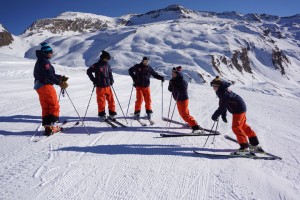
Most people when asked “what do you wish to achieve during this lesson” will focus on success, however, it is openness to failure that sets the really successful learners apart.
This memoir has been forged by Coach Paul, from a reflective foundation of many years teaching people ‘how to learn’. He is a director of TDC, an inspirational ski teacher and lecturer at the University of Gloucestershire in Sports Coaching.
Staff training 18 March 2011
The staff training program continues to run through the whole fo the season with the development centre. This week we were looking for off piste routes accessible with clients. The snow is good on most aspects. We had a great time…
Tignes Glacier skiing
Whilst the final touches are being made to the renovated chalets and Hotels in Val d’Isere and Tignes, the glacier is being put to good use. Not only are TDC coaches running pre-season BASI prep courses and slalom training, but national teams have been up on the hill making their final preparations for the World and Europa cups.
See how the slalom training is getting on at: http://www.youtube.com/thedevelopmentcentre
All our coaches regularly use video analysis as a tool for teaching and all you need to do is ask you coach. You may even feature on this site!
